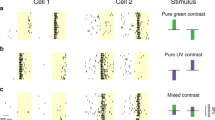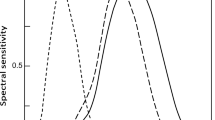Abstract
Equations have been derived that improve the quantification of sensory equidistant colour and lightness differences. This has been achieved by a physiological approach involving non-linear responses of cone mechanisms and two subsequent stages of linear opponent transformation to describe the Munsell System (Seim and Valberg, 1980). Using the formulation for the first opponent stage, colours induced into an achromatic center field by a chromatic surround varying in purity, are shown to follow the same power function of the opponent coordinates for all hues. By analogy, a physiological model for colour coding and colour induction is offered. Double opponent neurones with spatially antagonistic, spectrally opponent and symmetric receptive fields constitute the units of the model. Colour induction is related to lateral excitation and colour differences to response differences of these units.
Similar content being viewed by others
References
Baumgartner, G.: Die neuronale Aktivität des visuellen Systems der Katze und ihre Beziehungen zur subjektiven Sinnesphysiologie. Habilitation. Thesis, Universität Freiburg 1960
Boynton, R.M.: Human color vision. New York: Holt, Rinehart, and Winston 1979
Creutzfeldt, O.D., Lee, B.B., Elephant, A.: A quantitative study of chromatic organisation and receptive fields of cells in the lateral geniculate body of the rhesus monkey. Exp. Brain Res. 35, 527–545 (1979)
Daw, N.W.: Colour-coded ganglien cells in the goldfish retina. Extension of their receptive fields by means of new stimuli. J. Physiol. 1971, 567–592 (1968)
Hunt, R.W.G.: Light and dark adaptation and the perception of color. J. Opt. Soc. Am. 42, 190–199 (1952)
Hunt, R.W.G.: The perception of color in 7° fields for different states of adaption. J. Opt. Soc. Am. 43, 479–484 (1953)
Hunt, R.W.G.: Measurement of color appearance. J. Opt. Soc. Am. 55, 1540–1551 (1965)
Jameson, D., Hurvich, L.M.: Opponent chromatic induction: experimental evaluation and theoretical account. J. Opt. Soc. Am. 51, 46–53 (1961)
Jameson, D., Hurvich, L.M.: Color adaptation: sensitivity, contrast, and after-images. In: Handbook of sensory physiology. Vol. VII/4. Visual psychophysics, pp. 568–581. Jameson, D., Hurvich, L.M. (eds.). Berlin, Heidelberg, New York: Springer 1972
Jung, K.: Visual perception and neurophysiology. In: Handbook of sensory physiology. Vol. VII/3. Central visual information A, pp. 1–152. Jung, R. (ed.). Berlin, Heidelberg, New York: Springer 1973
Kaneko, A., Tachibana, M.: Retina bipolar cells with double colour-opponent receptive fields. Nature 293, 220–222 (1981)
Kries, J. von: Die Gesichtsempfindungen. Nagels Handbuch der Physiologie des Menschen. III, pp. 109–282. Braunschweig: Vieweg Verlag 1905
MacAdam, D.L.: A nonlinear hypothesis for chromatic adaptation. Vision Res. 1, 9–41 (1961)
MacAdam, D.L.: Chromatic adaptation. II. Nonlinear hypothesis. J. Opt. Soc. Am. 53, 1441–1445 (1963)
Michael, C.R.: Opponent-colour and opponent contrast cells in lateral geniculate nucleus of the ground squirrel. J. Neurophysiol. 36, 536–550 (1973)
Michael, C.R.: Color vision mechanisms in monkey cortex: dual-opponent cells with concentric receptive fields. J. Neurophysiol. 41, 572–588 (1978a)
Michael, C.R.: Color vision mechanisms in monkey striate cortex: Simple cells with dual opponent-color receptive fields. J. Neurophysiol. 41, 1233–1249 (1978b)
Michael, C.R.: Color-sensitive complex cells in monkey striate cortex. J. Neurophysiol. 41, 1250–1266 (1978c)
Nayatani, Y., Takahama, K., Sobagaki, H.: Estimation of adaptation effects by use of a theoretical nonlinear model. Proceedings 19th session of CIE, Kyoto 1979. Publication CIE 50, 490–494 (1980)
Pitt, F.H.G.: The nature of normal trichromatic and dichromatic vision. Proc. R. Soc. (London) B 132, 101–107 (1944)
Pokorny, J.: Modeling blue-yellow opponency. Proceedings AIC Color 81, Berlin, September 1981, S. 7
Raynauld, J.-P.: Goldfish retina: sign of rod input in opponent color ganglion cells. Science 177, 84–85 (1972)
Scheibner, H.: Untersuchungen zur Farbumstimmung des menschlichen Auges. Die Farbe 12, 6–58 (1963)
Seim, T., Valberg, A.: Physiological response and the scaling of colour differences. Exp. Brain Res. 41, A 39 (1980)
Seim, T., Valberg, A.: Uniformity of lightness and color: a new formula to describe the Munsell system. J. Opt. Soc. Am. (submitted) (1982)
Shevell, S.K.: The dual role of chromatic backgrounds in color perception. Vision Res. 18, 1649–1661 (1978)
Spekreijse, H., Wagner, H.G., Wolbarsht, M.L.: Spectral and spatial coding of ganglion cell responses in goldfish retina. J. Neurophysiol. 35, 73–85 (1972)
Valberg, A.: Non-linear chromatic induction. Die Farbe 19, 283–294 (1970)
Valberg, A.: A method for the precise determination of achromatic colors including white. Vision Res. 11, 157–160 (1971)
Valberg, A.: Color induction. Dependence on luminance, purity, and dominant or complementary wavelength of inducing stimuli. J. Opt. Soc. Am. 64, 1531–1540 (1974a)
Valberg, A.: Lateral interaction between large retinal stimuli and symmetric receptive fields. Phys. Norv. 7, 227–235 (1974b)
Valberg, A.: Color induction. A study of lateral interaction in human vision. University of Oslo, 1975
Valberg, A., Seim, T.: Color induction and physiological response. ARVO-abstract, 1981
Wagner, H.G.: Valenzmetrische Untersuchungen der Farbum-stimmung. Die Farbe 17, 229–284 (1968)
Walraven, J.: Discounting the background — the missing link in the explanation of chromatic induction. Vision Res. 16, 289–295 (1976)
Walraven, J.: Perceived colour under conditions of chromatic adaptation: Evidence for gain control by π mechanisms. Vision Res. 21, 611–620 (1981)
Wiesel, T.N., Hubel, D.H.: Spatial and chromatic interactions in the lateral geniculate body of the rhesus monkey. J. Neurophysiol. 29, 1115–1156 (1966)
Wright, W.D.: The measurements and analysis of colour adaptation phenomena. Proc. R. Soc. (London) B 115, 49–87 (1934)
Wyszecki, G., Stiles, W.S.: Color science. New York. Wiley 1967
Author information
Authors and Affiliations
Rights and permissions
About this article
Cite this article
Valberg, A., Seim, T. Chromatic induction: Responses of neurophysiological double opponent units?. Biol. Cybern. 46, 149–158 (1983). https://doi.org/10.1007/BF00339983
Received:
Issue Date:
DOI: https://doi.org/10.1007/BF00339983




